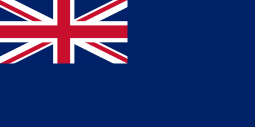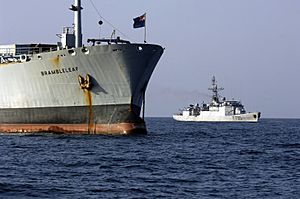Blue Ensign facts for kids
 |
|
| Use | State ensign |
|---|---|
| Proportion | 1:2 |
| Adopted | British Government |
| Design | Blue with the Union occupying one quarter of the field and placed in the canton. |
The Blue Ensign is a special flag used by certain groups or places connected to the United Kingdom. It's one of several British flags called "ensigns." You might see it as a plain blue flag or with a special badge or symbol added to it.
This flag started way back in the 1600s. Back then, it had the St George's Cross (the flag of England) in the top corner near the flagpole, and the rest of the flag was blue.
When England and Scotland joined together to form the Kingdom of Great Britain in 1707, the Union Jack flag changed. The Blue Ensign changed too, to include the new Union Flag in its top corner. Later, in 1801, when Ireland joined to form the United Kingdom of Great Britain and Ireland, the St Patrick's Cross was added to the Union Flag. This new Union Flag then appeared on all British ensigns, including the Blue Ensign.
Contents
Plain Blue Ensign: What is it?
Before 1864, the plain Blue Ensign was used by one part of the Royal Navy called the Blue Squadron. But things changed in 1864. A new rule said that:
- The Red Ensign would be for regular merchant ships.
- The Blue Ensign would be for ships used by the government or ships commanded by an officer from the Royal Naval Reserve (people who can be called to serve in the Navy if needed).
- The White Ensign would be only for the Navy itself.
So, since 1864, the plain Blue Ensign (without any extra symbols) can be flown by three types of civilian ships:
- British merchant ships that have a certain number of retired Royal Navy members or Royal Naval Reservists among their crew. The rules for this have changed over the years.
- Royal Research Ships, which are vessels used for scientific research.
- British-registered yachts that belong to members of certain special yacht clubs. There are many such clubs, including the Royal Thames Yacht Club and the Royal Sydney Yacht Squadron. During World War I and World War II, yachts were not allowed to fly this flag.
Defaced Blue Ensign: What does "defaced" mean?
When a flag is "defaced," it means it has an extra badge or symbol added to it. Since 1864, the Blue Ensign has been "defaced" to create flags for different UK government departments or public groups.
Here are some examples of groups that use a defaced Blue Ensign:
 |
Government Service Ensign (a general flag for government ships) |
 |
His Majesty's Coastguard (who protect our coasts) |
 |
Metropolitan Police (London's police force) |
 |
Ministry of Defence Police (who protect military sites) |
 |
Royal Fleet Auxiliary Service (ships that support the Royal Navy) |
 |
Sea Cadet Corps (a youth organization) |
Even the Royal Air Force used a defaced Blue Ensign for their marine vessels, like seaplane tenders. It had an eagle and an anchor on it.
Some yacht clubs also have their own defaced Blue Ensigns with their club's badge. These are now managed by the Royal Yachting Association. Some examples include:
 |
Bar Yacht Club |
 |
Little Ship Club |
 |
Medway Yacht Club |
 |
Royal Bermuda Yacht Club |
 |
Royal Channel Islands Yacht Club |
 |
Royal Corinthian Yacht Club |
 |
Royal Cornwall Yacht Club |
 |
Royal Forth Yacht Club |
 |
Royal Gibraltar Yacht Club |
 |
Royal Harwich Yacht Club |
 |
Royal Ulster Yacht Club |
 |
The Poole Yacht Club |
Flags of Crown Dependencies and Overseas Territories
Many British Crown Dependencies (like Jersey and Guernsey) and British Overseas Territories (like the Falkland Islands and Bermuda) use flags based on the defaced Blue Ensign. This means their flags have the Union Jack in the corner and a special symbol for their territory on the blue background.
Current flags:
 Government Ensign of Alderney
Government Ensign of Alderney Government Ensign of Guernsey
Government Ensign of Guernsey Government Ensign of Jersey
Government Ensign of Jersey Flag of Anguilla
Flag of Anguilla Government Ensign of Bermuda
Government Ensign of Bermuda Flag of the British Virgin Islands
Flag of the British Virgin Islands Flag of the Cayman Islands
Flag of the Cayman Islands Flag of the Falkland Islands
Flag of the Falkland Islands Government Ensign of Gibraltar
Government Ensign of Gibraltar Flag of Montserrat
Flag of Montserrat Flag of the Pitcairn Islands
Flag of the Pitcairn Islands Flag of Saint Helena
Flag of Saint Helena Flag of the Turks and Caicos Islands
Flag of the Turks and Caicos Islands
Former flags: The defaced Blue Ensign was also used as the flag for many places that were once part of the British Empire.
- The flag of Bengal Presidency in India for many years.
- The flag of the Gilbert and Ellice Islands Colony (now Kiribati and Tuvalu) from 1937 to 1976.
- The "jack" (a smaller flag flown at the bow of a ship) for the Royal Canadian Navy until 1965.
-
 Blue Ensign worn as a jack by the Royal Canadian Navy 1957–1965 (with red maple leaves in the shield)
Blue Ensign worn as a jack by the Royal Canadian Navy 1957–1965 (with red maple leaves in the shield)
- The flag for the Royal Indian Navy for many years.
- The flag of the United States of the Ionian Islands (a British protectorate in Greece) from 1815 to 1864.
- The flag of British Hong Kong from 1870 to 1997.
- The flag of Weihaiwei (a British territory in China) from 1903 to 1930.
- The flag of Newfoundland (now part of Canada) from 1870 to 1931. This flag had a special badge showing the god Mercury and Britannia with a fisherman.
- The Blue Ensign was also flown over the offices of the Union of South Africa abroad from 1910 to 1928.
National flags based on the Blue Ensign
Many countries that were once part of the British Empire have flags that look similar to the Blue Ensign. They often have the Union Jack in the corner and a special symbol for their country on a blue background. These include:
 Flag of Australia
Flag of Australia
 Flag of Fiji (this one is light blue)
Flag of Fiji (this one is light blue) Flag of New Zealand
Flag of New Zealand
 Flag of Tuvalu (this one is also light blue)
Flag of Tuvalu (this one is also light blue)
Other flags based on the Blue Ensign
 Flag of Ceylon (now Sri Lanka)
Flag of Ceylon (now Sri Lanka)- Ensign of The Royal Hospital School
 George Rex Flag
George Rex Flag Tanganyika Territory blue ensign
Tanganyika Territory blue ensign Fijian government ensign
Fijian government ensign
 Flag of Australasia team at the Olympic games
Flag of Australasia team at the Olympic games Flag of the Blood 148 Kainai Nation (an Indigenous group in Canada)
Flag of the Blood 148 Kainai Nation (an Indigenous group in Canada) Flag of Britain First Party
Flag of Britain First Party
See also
- Australian flag debate
- Ensign (a type of flag)
- Green Ensign
- Historical flags of the British Empire and the overseas territories
- New Zealand flag debate
- Red Ensign
- White Ensign












